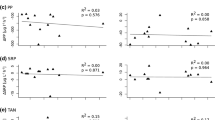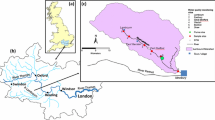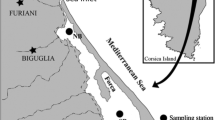Abstract
We examined photopigment degradation and transformation in sediment microcosms that received different detrital source materials (planktonic, littoral, terrestrial) in the presence or absence of amphidpods (Gammarus sp.). Additions of realistic quantities of particulate organic matter resulted in detectable changes in pigment concentration and composition despite insignificant changes in total organic matter. The transformation of chlorophyll a to total phaeophorbide was significantly higher in all high quality (high nitrogen) detritus treatments containing amphipods. The highest production of phaeophorbide was in the higher quality detritus (blue-green algae, Anabaena cylindrica, and macrophyte, Vallisneria americana) when compared to red maple (Acer rubrum). Phaeophytin formation was not related to amphipod grazing and thus may be determined more by microbial heterotrophic processes. The degradation product of the carotenoid lutein, lutein 5,6 expoxide, was formed in all treatments. Phaeopigment composition can be used to infer differences in heterotrophic activity and will help in the interpretation of photopigment distribution in field samples.
Similar content being viewed by others

References
Bianchi TS & Findlay S (1990) Plant pigments as tracers of emergent and submergent macrophytes from the Hudson River. Can. J. Fish. Aquat. Sci. 47: 492–494
Bianchi TS & Findlay S (1991) Decomposition of Hudson estuary macrophytes: Photosynthetic pigment transformations and decay constants. Estuaries 14: 67–73
Bianchi TS, Dawson R & Sawangwong P (1988) The effects of macrobenthic depositfeeding on the degradation of chloropigments in sandy sediments. J. Exp. Mar. Biol. Ecol. 122: 243–255
Bloesch J, Stadelmann P & Buhrer H (1977) Primary production, and sedimentation in the euphotic zone of two Swiss lakes. Limnol. Oceanogr. 22: 511–526
Braumann T & Grimme LH (1981) Reversed-phase high-performance liquid chromatography of chlorophylls and carotenoids. Biochim. et Biophys. Acta. 637: 8–17
Bricelj VM (1984) Effects of suspended sediments on the feeding physiology and growth of the hard clam Mercenaria mercenaria. Ph.D thesis, State University of New York at Stony Brook, 157 pp
Brown LM, Hargrave BT & MacKinnon MD (1981) Analysis of chlorophyll- a in sediments by high-pressure liquid chromatogrphy. Can. J. Fish. Aquat. Sci. 38: 205–957
Carpenter SR & Bergquist AM (1985) Experimental tests of grazing indicators based on chlorophyll a degradation products. Arch. fur Hydrobiol. 102: 303–317
Daley RJ (1973) Experimental characterization of lacustrine chlorophyll diagenesis. II. Bacterial, viral and herbivore grazing effects. Arch. fur Hydrobiol. 72: 409–439
Davies BH (1976) Carotenoids. In: Goodwin TW (Ed) Chemistry and Biochemistry of Plant Pigments (pp 38–165). Academic
Findlay S & Tenore KR (1982) Nitrogen source for a detritivore: detritus substrate versus associated microbes. Science 218: 371–373
Furlong ET & Carpenter R (1988) Pigment preservation and remineralization in oxic coastal marine sediments. Geochim. Cosmochim. Acta 52: 87–99
Gorham E (1960) Chlorophyll derivatives in surface muds from the English Lakes. Limnol. Oceanogr. 5: 29–33
Gurevitch J & ST Chester (1986) Analysis of repeated measures experiments. Ecol. 67: 251–255
Harrison PG (1982) Control of microbial growth and of amphipod grazing by water-soluble compounds from leaves of Zostera marina. Mar. Biol. 67: 225–230
Hawkins AJS, Bayne BL, Mantoura RFC, Llewellyn CA & Navarro E (1986) Chlorophyll degradation and adsorption throughout the digestive system of the blue mussel Mytilus edulis. J. Exp. Mar. Biol. Ecol. 96: 213–223
Henebry MS & Gorden RW (1988 (89)) Bacterial biomass and production in Mississippi River Pool 19. Hydrobiologia 182: 15–23
Jeffrey SW (1974) Profiles of photosynthetic pigments in the ocean using thin-layer chromatography. Mar. Biol. 26: 101–110
Jeffrey SW & Hallegraeff GM (1987) Chlorophyllase distribution in ten classes of phytoplankton: a problem for chlorophyll analysis. Mar. Ecol. Prog. Ser. 35: 293–304
Klein B, Gieskes WWC & Kraay GW (1986) Digestion of chlorophylls and carotenoids by the marine protozoan Oxyrrhis marina studied by h.p.l.c analysis of algal pigments. J. Plankton Res. 8: 827–836
Leavitt PR & Carpenter SR (1991) Pigment degradation in lakes: implications for sedimentation studies and paleolimnology. Limnol. Oceanogr. 34: (in press)
Mantoura RFC & Llewellyn CA (1983) The rapid determination of algal chlorophyll and carotenoid pigments and their breakdown products in natural waters by reverse-phase high-performance liquid chromatogrphy. Anal. Chim. Acta 151: 297–314
Peterson BJ & Howarth RW (1987) Sulfur, carbon, and nitrogen isotopes used to trace organic matter flow in the salt-marsh estuary of Sapelo Island, Georgia. Limnol. Oceanogr. 32: 1195–1213
Repeta DJ (1989) Early diagenesis of carotenoids in recent marine sediments — II. Degradation of fucoxanthin to loliolides. Geochim. Cosmochim. 53: Acta. 699–707
Repeta DJ & Gagosian RB (1987) Carotenoid diagenesis in recent marine sediments—1. The Peru continental shelf (15 S, 75 W). Geochim. Cosmochim. Acta 51: 1001–1009
Rice DL & Tenore KR (1981) Dynamics of carbon and nitrogen during the decomposition of detritus derived from estuarine macrophytes. Estuar. and Coast. Shelf Sci. 13: 681–690
Rioux-Gobin C, Llewellyn CA & Klein B (1987) Microphytobenthos from two subtidal sediments from North Brittany. II. Variations of pigment compositions and concentrations determined by HPLC and conventional techniques. Mar. Ecol. Prog. Ser. 40: 275–283
Sanger JE & Gorham E (1970) The diversity of pigments in lake sediments and its ecological significance. Limnol. Oceanogr. 15: 59–69
Shuman FR & Lorenzen CJ (1975) Quantitative degradation of chlorophyll by a marine herbivore. Limnol. Oceanogr. 20: 580–586
Simpson KW, Fagnani JP, Bode RW, DeNicola DM & Abele LE (1986) Organism-substrate relationships in the main channel of the Lower Hudson River. J. North Amer. Benthol. Soc. 5: 41–57
Sokal RS & Rohlf FJ (1981) Biometry. W.H. Freeman and Company
Tenore KR, Cammen L, Findlay S & Phillips N (1982) Perspectives of research in detritus: Do factors controlling availability of detritus to consumers depend on its source? J. Mar. Res. 40: 473–490
Valiela, I (1984) Marine Ecological Processes. Springer-Verlag
Valiela I, Koumjian L, Swain T, Teal JM & Hobbie JE (1979) Cinnamic acid inhibition of detritus feeding. Nature 280: 55–57
Watts CD, Maxwell JR & Kjosen L (1977) The potential of carotenoids as environmental indicators, In: Campos R & Goni J (Eds) Advances in Organic Geochemistry (pp 391–413). Pergamon
Webster JR & Benfield EF (1986) Vascular plant breakdown in freshwater ecosystems. Ann. Rev. Ecol. Syst. 17: 567–594
Welschmeyer NA & Lorenzen CJ (1985) Chlorophyll budgets: Zooplankton grazing and phytoplankton growth in a temperate fjord and the Central Pacific Gyres. Limnol. Oceanogr. 30: 1–21
Wetzel RG (1983) Limnology. Saunders College Publishing Wright SW & Jeffrey SW (1987) Fucoxanthin pigment markers of marine phytoplankton analysed by HPLC and HPTLC. Mar. Ecol. Prog. Ser. 38: 259–266
Zeitzschel B (1980) Sediment-water interactions in nutrient dynamics. In: Tenore KR & Coull BC (Eds) MArine benthic dynamics (pp 195–218). University of South Carolina Press, Columbia
Author information
Authors and Affiliations
Rights and permissions
About this article
Cite this article
Bianchi, T.S., Findlay, S. & Fontvieille, D. Experimental degradation of plant materials in Hudson river sediments. Biogeochemistry 12, 171–187 (1991). https://doi.org/10.1007/BF00002606
Accepted:
Issue Date:
DOI: https://doi.org/10.1007/BF00002606



